
OceansArt.US
|
Lima, Peru is the capital of Lima Province and largest city in Peru. It is the cultural and economic hub of the country. Lima occupies the valleys of the Chillón, Rímac and Lurín rivers. It lies on a desertic coast overlooking the Bay of Lima in the Pacific Ocean where its port was built and named Callao. Lima was founded by Spanish conquistador Francisco Pizarro on January 18, 1535, as the City of Kings. It became the most important city in the Spanish Viceroyalty of Peru, an administrative area encompassing most of Spain's possessions in South America during the colonial era (mid 1500s to early 1800s). For more than three centuries, Lima was the greatest metropolis in South America. Today nearly one-third of the nation's population lives in this one metropolitan area. There is more about Lima below the photos.
(Adapted from: Lima, Peru. (2008). From Wikipedia, The Free Encyclopedia and from the Embassy of Peru)
See all the free photos, including other photos of Peru by going to the Photo Catalog. Click on any picture for a FREE larger version. Read the licensing rules (REVISED) for your needs. There are hundreds of high quality free photos: use the Google/site search engine. See our digital photography tips : DOs and Don'ts; Choosing a Camera and Accessories , Downloading Photos, and Editing Photos. Visit TechnologySite.org for free photos and lists of inventions and technology and learn Climate Change Facts to see for yourself if your area is at risk from global warming or global cooling.
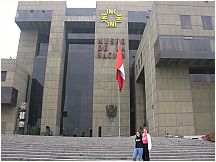 01limaperucityciudad.jpg Museo De La Nacion. Museum of the Nation in Lima, Peru |
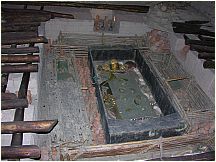 02limaperucityciudad.jpg Inca burial chamber and offerings for a noble Inca, on display en la Museo De La Nacion en Lima, Peru |
|
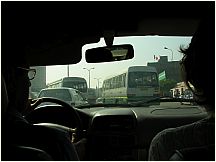 03limaperucityciudad.jpg View of buses (Micros or Combis) and cars city traffic in Lima, Peru |
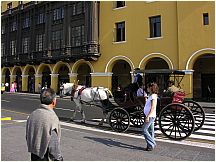 04limaperucityciudad.jpg Horse drawn toursit coach in Lima, Peru at the Plaza de Armas, going past Lima City Hall (or Municipal Palace) |
|
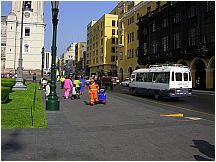 05limaperucityciudad.jpg Combi bus Lima, Peru at the Plaza de Armas |
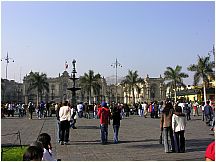 06limaperucityciudad.jpg Lima, Peru at the Plaza de Armas, the location where Francisco Pizarro founded Lima and where, in 1821, the Act of Independence of Peru was declared. |
|
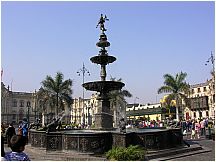 07limaperucityciudad.jpg Fountain in the center of the Plaza de Armas in Lima, Peru |
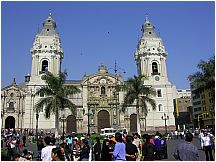 08limaperucityciudad.jpg Lima Cathedral, Lima, Peru at the Plaza de Armas. The Cathedral, is a symbol of the city., countruction started the same year the city was founded, in 1535 |
|
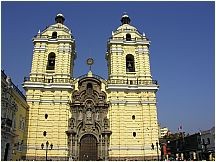 09limaperucityciudad.jpg The convent of San Francisco, the chapels of the Solitude and the Miracle, and the Museum of Religious Art and the Zurbarán Room. Underneath are galleries and catacombs. |
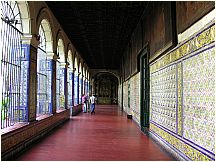 10limaperucityciudad.jpg The beautiful cloisters of the San Francisco church in Lima, Peru are decorated with Sevillian style tiles. |
|
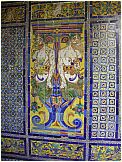 11limaperucityciudad.jpg The beautiful cloisters of the San Francisco church in Lima, Peru are decorated with Sevillian style tiles. |
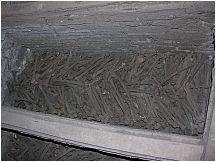 12limaperucityciudad.jpg Under the San Francisco church in Lima, Peru are bins of bones, some of all types or perhaps just femurs or tibias (as shown) or skulls, or some combination. Many are arranged in a design. |
|
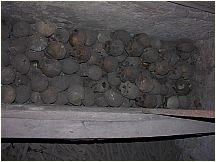 13limaperucityciudad.jpg Under the San Francisco church in Lima, Peru are bins of bones, some of all types or perhaps just femurs or tibias or skulls (as shown), or some combination. Many are arranged in a design. |
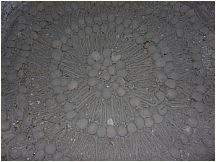 14limaperucityciudad.jpg Under the San Francisco church in Lima, Peru are bins of bones, some of all types or perhaps just femurs or tibias or skulls, or some combination. Many are arranged in a design (as shown) . |
|
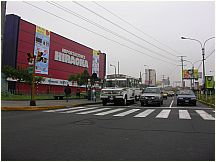 15limaperucityciudad.jpg View of cars and micro buses in city traffic in Lima, Peru |
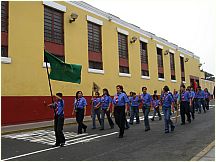 16limaperucityciudad.jpg Girl Scouts and Boy Scouts in a parade in Lima, Peru |
|
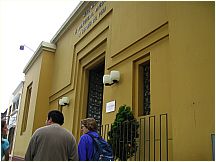 17limaperucityciudad.jpg Entrance of the National Museum of Anthropology, Archaeology, and History of Peru in Lima, Peru |
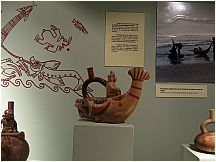 18limaperucityciudad.jpg Inca pottery showing an Inca sitting on a huge fish in the National Museum of Anthropology, Archaeology, and History of Peru in Lima, Peru |
|
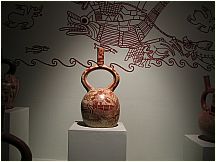 19limaperucityciudad.jpg Inca pottery showing an Inca fishing with line from a boat at the National Museum of Anthropology, Archaeology, and History of Peru in Lima, Peru |
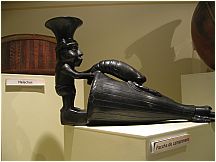 20limaperucityciudad.jpg Inca pottery showing an Inca with a shrimp and shrimp trap in the National Museum of Anthropology, Archaeology, and History of Peru in Lima, Peru |
|
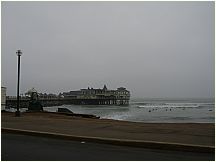 21limaperucityciudad.jpg Pier with restaurants and attractions on the "Costa Verde" (Green Coast) of Lima Province in Peru. Taken from the "Circuito de Playas" (Beach Circuit) |
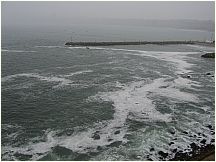 22limaperucityciudad.jpg View of a small harbor on the "Costa Verde" (Green Coast) of Lima Province in Peru. Taken from a bluff along the "Circuito de Playas" (Beach Circuit) |
|
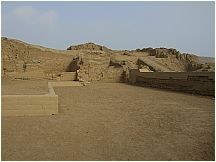 23limaperucityciudad.jpg Pachacamac Archaeological Project just south of Lima, Peru on the Pacific Ocean. |
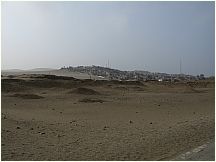 24limaperucityciudad.jpg Pachacamac Archaeological Project, showing how the limits of the Preserve have stopped the development from overtaking the site. |
|
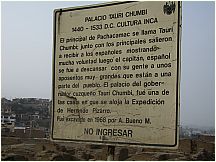 25limaperucityciudad.jpg Sign at Pachacamac on the central coast of Peru, quoting descriptions from the Spanish scholars, including that Pizarro rested here, when he first came to Peru |
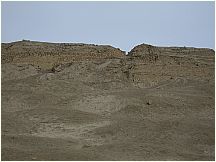 26limaperucityciudad.jpg Pachacamac on the central coast of Peru has long been known as the preeminent religious pilgrimage center of pre-Hispanic Peru. |
|
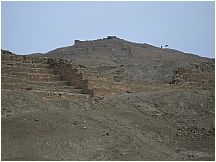 27limaperucityciudad.jpg Pachacamac on the central coast of Peru has long been regarded as the preeminent religious and/or pilgrimage center of pre-Hispanic Peru. |
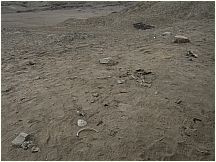 28limaperucityciudad.jpg Textiles and other woven materials and skeletal remains from some funerary bundles lying open on the ground as latterday people's footprints record their presence. |
|
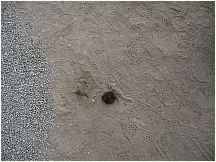 29limaperucityciudad.jpg Human hair, textiles and other woven materials and skeletal remains lying open on the ground among footprints at Pachacamac, near Lima Peru. |
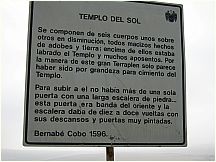 30limaperucityciudad.jpg Sign at Templo Del Sol (Temple of the Sun), written in 1596, describing the temple and its 6 levels. |
|
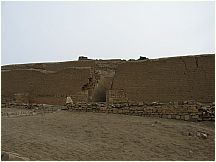 31limaperucityciudad.jpg Pachacamac, Peru. The Painted Temple, constructed of adobe bricks and tapia (pounded earthen blocks). |
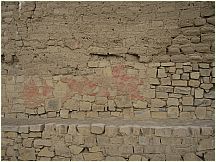 32limaperucityciudad.jpg Pachacamac, Peru. The Painted Temple, contstructed of adobe bricks and tapia (pounded earthen blocks). |
|
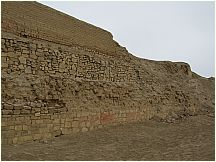 33limaperucityciudad.jpg Pachacamac, Peru. There are 14 Pyramids with Ramps. |
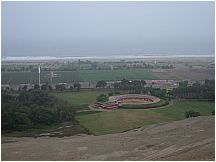 34limaperucityciudad.jpg From the temple at Pachacamac, Peru. looking towards the Pacific Ocean orver a bullring |
|
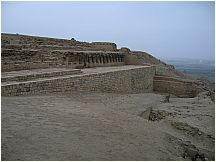 35limaperucityciudad.jpg Pachacamac, south of Lima, Peru. The ocean side of the Painted Temple, constructed of adobe bricks and tapia (pounded earthen blocks). This was a cerimonial and sacrificial area. |
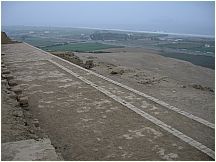 36limaperucityciudad.jpg Pachacamac, south of Lima, Peru. The ocean side of the Painted Temple, constructed of adobe bricks and tapia (pounded earthen blocks). This was a cerimonial and sacrificial area. |
|
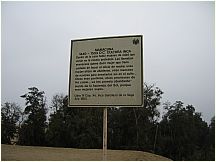 37limaperucityciudad.jpg Sign at Acllausi describing the role of the "chosen ones", young girls who were trained to serve the needs of the rulers. There were six ranks , ranging from those who served the Sun, the Moon, the Thunder and the Stars down to the lowest rank, used as a commodity by the nobles and priests. |
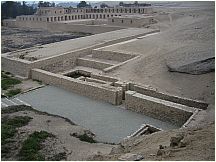 38limaperucityciudad.jpg Acllahuasi at Pachacamac, south of Lima, Peru. Here in Incan times, 1440 - 1533, women were trained to run households and to serve gods or rulers, depending on their class. |
The location of the city was decided at Epiphany (January 6), the day of the Three Kings, and Francisco Pizarro named it Tres Veces Coronada Ciudad de los Reyes. Lima, its original name, however, persisted. It is uncertain where the name originated; it may derive either from the Aymara word lima-limaq, (yellow flower) or from Quechuan rimaq (talking). In the oldest Spanish maps of Peru, Lima and Ciudad de los Reyes (City of Kings) can be seen together as names of the city. The river that feeds Lima is still called Rimac, Quechua for "Talking river" (Río Hablador).
Lima's climate is quite mild, despite being located in the Tropics. Lima has a subtropical and desertic climate, yet the microclimate also makes it very humid. The temperatures vary from mild to warm.The average temperature is 18°C to 19ºC (60-65°F). The lowest temperatures vary from 12°C (50s°F) to around 20°C (68°F) and the high average is around 25°C (78°F), with 30°C (86°F) in the warmest of days. One must remember to wear tight sweaters (no jackets are needed) in the winters and never forget to put sun block on when going to the beach during summers. Relative humidity is very high, and produces brief morning fog from June to December and persistent low clouds from May to November. Sunny, less moist and warm summers follow from December to April and are followed by cloudy, damp and cool winters (June to October. Rainfall is almost unknown. The yearly average of 0.7 cm (0.3in) reported at the airport is the lowest of any large metropolitan area in the world. Inland locations receive 1 to 6 cm of rainfall, which accumulates mainly during the winter months. Summer rain occurs in the form of isolated light and brief afternoon or evening events, leftover from afternoon storms that generate over the Andes. The peak of the 'rainy season,' which really does not apply, occurs during winter when late-night/morning drizzle events (locally called 'garúa','llovizna' or 'camanchacas') become frequent. All these climatic phenomena arise from the combination of semi-permanent coastal upwelling and the presence of the cold Humboldt Current just offshore.
One thing to take into consideration is that because of the coast,
hills and valleys, there is no single climate for all of Lima. For
example, in winter the Surco area of Lima which is closer to the
coast will be cool and damp. In contrast, the more elevated next
district La Molina area will be warmer and drier. The Cieneguilla
area, about 30 minutes drive to the East of La Molina, provides sunshine
and spring-like weather seemingly year round. Lima is described as
having micro-climates; while winter is generally winter in all of
Lima, a 30 minute drive in any direction can put you in a slightly
warmer, drier, wetter or colder area depending on your elevation and distance
to the coast. Same goes for the other seasons.
The Lima Metropolis ranks among Latin America's largest and densest urban concentrations, with estimated populations (as of 2005) of 7.6 million for the urban area, 7.8 million for the entire province, and 9.2 million for the Lima and Callao Metropolitan Area. The population of Lima features a very complex mix of racial and ethnic groups. Traditionally, Mestizos of mixed Spanish and Amerindian descent are the largest contingent. However, political and economic instability in Peru during the latter half of the twentieth century created unprecedented poverty and violence in the towns of the countryside or Andean highlands, forcing hundreds of thousands of peasants of full-blooded Amerindian descent to migrate to Lima — thus greatly augmenting Lima's population. Unlike other ethnic groups in Lima who speak only Spanish, most of the peasant population that migrated to Lima speaks primarily Quechua or Aymara, rather than Spanish. While a number of Amerindians eventually attain middle class status, others still live in shantytowns, known locally as pueblos jóvenes (young towns). These areas often lack such basic services as electricity and running water. It is expected that over the next ten years, the population of these shantytowns will decrease to 8% of the population of Lima. Europeans, the economically dominant segment of the population, are mostly of Spanish descent, but there are significant numbers of Italians, Germans, and Middle Easterners. Afro-Peruvians, initially brought to the region as slaves, are yet another important part of the city's ethnic quilt, and Asians, an even smaller one.
(Adapted from: Lima, Peru. (2008). From Wikipedia, The Free Encyclopedia and from the Embassy of Peru)
This page last updated January 2015
Visit http://www.TechnologySite.org for free
photos and lists of inventions and technology. Visit http://www.ClimateChangeFacts.info for unbiased
information about climate change. Visit http://www.ClimateCooling.org for eye-opening
biased information on global cooling and climate change and visit http://www.OceanAssoc.com for fisheries
and oceans consulting services.